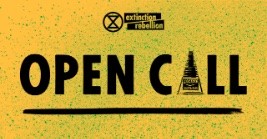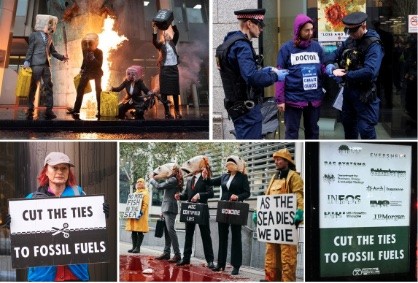Style Guide
When information is consistent in visual appearance, language and formatting, it is easier to understand and disseminate. It becomes instantly recognisable as the XR voice and it fits within the wider context of the movement, lending it strength.
Design
See the Design Programme for fonts, logos, colours, images, icons etc.
Be consistent in the name and image used for the event/action across all platforms.
Accessibility
Consider accessibility: It is key in reaching as many people as possible and growing our movement. Mention where people can find out more about physical accessibility.
Write for a teenager for whom English is second language. Keep sentences short and use plain English, not academic terminology. Don’t assume knowledge, for example make clear what abbreviations stand for.
See Accessible documents for advice on making your communication accessible, including for considering colour blindness and dyslexia.
Banner Images
- Use Fucxed Caps (the main XR font).
- Colour scheme: use colours from the XR Design Programme (this can include different shades of one colour).
- Limit the words in a visual banner. Put a short title only into the image. Text in images is not fully accessible as it cannot be read by screen reader technology. Keep the design clean and readable.
- Use one font size for the banner design (or two max). Keep it simple and clear.
- Centralise the text in the image.
- Use a consistent margin around the edge of the image for breathing space, so that the text or logo doesn’t sit on the edge of design.
- Check the image and text is in focus. Do not use it otherwise!
- Avoid too many overlays of images or text as it can be overwhelming.
- We advise using black or white text on a background colour for contrast and clarity. Make it clear.
- Consider dimensions (see below).
Spelling and grammar
This may not matter for some people, but for the rest, it is enough for them to abandon reading our posts. And for many it’s simply good manners.
When writing anything as XR, avoid:
- Spelling errors
- Grammar mistakes
Commonly misspelt words:
- Citizens’ Assembly; plural - Citizens’ Assemblies
- People’s Assembly; plural - People’s Assemblies
- De-escalation
- Nonviolence, nonviolent
- Wellbeing
- Campsite
- Any more (with a space)
- X-year-old
- XRUK (the hive and its subcircles, as opposed to "XR in the UK", which includes all the nations, regions, local groups, community groups, and so on)
Know the difference between:
- Their, There and They’re
- It’s and Its
- Lose and Loose
- To, Too and Two
Use apostrophes accurately or don’t use them at all.
Time
- Use a 24h clock or specify am/pm or AM/PM
- Include a colon, e.g. 17:00 or 05:00pm
Messaging app messages
General
- See the Rebellion Broadcast or Movement Broadcast Telegram channels for examples of well-formatted messages.
- Keep messages short. Link out to further information.
- For broadcast posts write like you are XR, not your individual voice.
- A broadcast post will get shared across different platforms so make sure the context is included (date/name of event) and that it says XRUK rather then ‘we’ or it won’t be clear where it’s from.
Headings
Put the message title in CAPS and in bold. Simply putting the title in bold or framed by emojis doesn’t translate well when it’s shared across channels, e.g. from Telegram to Signal or phone to laptop view.
Links
- Use XR’s link shortener to make links shorter. You’ll need an XR Hub account to create XR short links. If you don’t have one use TinyURL.
- Put weblinks on the next line after the text/colon: this is for accessibility as it’s easier to read.
- Don’t use direct (embedded) links on Telegram, share the full hyperlink instead, as messages are often shared-on to other platforms that may not support linking.
- Close linked windows (the cross in top right corner of the message) to reduce the message length and make a neater visual.
Images
- Don’t use an image unless it’s a good one, clear & dynamic with high contrast.
- The dimensions for using an image on Telegram are 1920 x 1005 (the same proportions as a Facebook event header)
- Keep it simple. One image is advised for the best effect, ideally in landscape. If you don’t have a strong image then no need to add one.
- Attach an image to the message, rather than posting it before on its own. This prevents it from getting lost when messages are forwarded.
- In Telegram, if you have multiple images you can attach them straight to the message and they will automatically form a grid.
- A general rule of thumb is max 5 images per collage, otherwise it risks becoming cluttered. A single image can sometimes be more striking.
- Aim for clear images (remember most people will view it on their phones).
- To make graphics (like the Open Call image below) use Aktavisda.
Example images:
Emojis
- Limit the use of emojis- less is more!
- Don’t frame a message title with emojis or use emojis at the end of a line. The emojis often jump lines when the message is shared to different devices or platforms (Android or iPhone, Signal or Telegram, phone or computer) and can end up looking messy.
- Just use one emoji at the start of the title, if you’re going to use them, and try to colour-coordinate with the header image.
- Use one space between image and emoji.
- Consider inclusivity when using emoji skin colours for hands etc. If you want to find more Telegram emojis including additional skin tones check out emojipedia.
Lists
- Precede lists with a colon.
- If lists need to be displayed (ie items on separate lines), consider using a bullet, asterisk or emoji before each item.
- If each item is in complete sentences, end with a full-stop. Otherwise, no punctuation at end of item except for a full stop at the end of the last one.
- For in-line lists, separate items by commas; avoid Oxford commas (comma after penultimate item, preceding an ‘and’).


